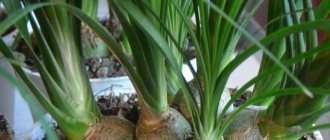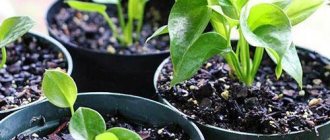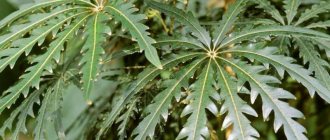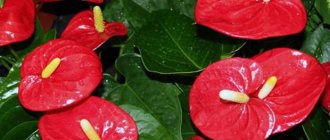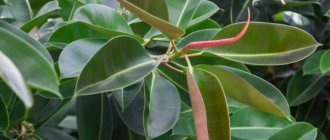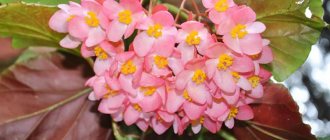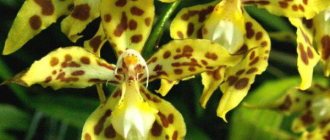Care after purchase
Ficus "Black Prince": care at home
When purchasing a plant, it is necessary to accurately determine the variety, since most suppliers often classify other varieties as it.
At home, the tree loses its natural ability to actively branch, but with proper care it can live for more than 40 years.
Watering
Watering is carried out with settled water as half of the top layer of the substrate dries.
Attention! Excessive moisture can lead to root rot and further death of the ficus elastica.
Bloom
The plant, as a rule, almost never blooms in any type of room.
In exceptional cases, ficus can please you with round fruits of yellow-green color, reaching a diameter of 1 cm.
Crown formation
- The formation of the crown of an already mature tree can occur in three ways:
- Pruning involves removing not only the top shoots, but also the nearby internodes (3-5 pieces).
- Fixing the trunk in a bent position, which will facilitate the replacement of a lateral bud with a dominant one.
- Puncture a tree trunk with a sterilized thick needle to 1/3 of its thickness in order to stimulate the emergence of new shoots.
Trimming
Shrubs are pruned only once per season - in the spring. The process is performed in the following sequence:
- Dried leaves are removed from the bottom of the bush.
- Withered buds are removed.
- Dried, diseased or rotten areas of roots are cut off.
- The upper part of the shoots is cut off.
Flower pruning can be done at home
Interesting! With proper care, you can grow a new flower from cut shoots.
Features of home care
In order for these varieties to please with their healthy and beautiful appearance, it is necessary to provide them with careful care.
Temperature
This genus of flowers loves warmth. In the warm season, it feels good at temperatures of +20-25 degrees. In the autumn, the temperature is lowered to 12-15 degrees, thus the flowers are gradually transferred to wintering.
Important! It is necessary to ensure that cold air does not reach the bushes and that there are no drafts around
Lighting
Anthurium should not be kept in direct sunlight. To make him feel comfortable, he is placed on the window sills on the western or eastern side of the home. If this is not possible, then you can darken the window or move the flower during the day.
Watering
Adult plants are watered abundantly as the top part of the soil dries out; a young flower is watered more often. The average amount is 2-3 times a week. Water should be done without touching the plant with water (water on the buds can form brown spots), using warm, clean water.
Important! The remaining water from the pan must be poured out immediately
Humidity
These plants love humidity, especially during hot weather. At this time, they should be sprayed and given a warm shower. You can also place a vessel with water nearby to increase air humidity.
In addition to the above methods, to provide moisture for plants, they resort to covering the stems with moss, which are sprayed periodically. In addition, you can place flowerpots with bushes on a tray with wet gravel and expanded clay.
Priming
Ready-made primer compositions are available for sale.
Ready-made soil from the store has the optimal composition
But you can prepare the soil yourself; for this you need to mix the following ingredients:
- charcoal;
- coarse sand;
- pine bark (medium sized pieces);
- sphagnum moss;
- humus;
- leaf soil.
Take 1 part of each component. You also need to add drainage.
Feeding
The plant must be fertilized from March to September so that it pleases with its beautiful and healthy appearance. During this period, feed the plant once a week.
It is preferable to choose ready-made fertilizers:
- "Forte" includes magnesium and succinic acid.
- "Bona Forte" No. 1 or No. 2. It is a complex of mineral and organic fertilizers.
They are used for watering and spraying according to the instructions on the package.
You can also prepare the solution at home yourself. To do this, use one of the following recipes:
- a teaspoon of sodium sulfate per 2-3 liters of water;
- a teaspoon of “Agroschool for flowering plants” per 2 liters of water;
- 0.5 liters of fermented mullein per 10 liters of water.
It is worth watering with different fertilizers in turn.
Note! Sick flowers are not fed. After transplantation, feed them after 2 weeks.
Anthurium Black Beauty, this hybrid plant, is considered a rare variety
A large anthurium, the height of an adult bush is 65-80 cm. The variety is distinguished by an abundance of leaf mass and a large number of peduncles. The leaf blade is medium-sized, oval, with a deeply heart-shaped base.
The leaves are dense, leathery, and the adult leaf has dark burgundy veins on the inside. Young leaves of burgundy color, over time, acquire a dark green color.
Anthurium Black Beauty belongs to the varieties of black anthuriums and is its darkest, almost black representative. The bedspread is not large in size, 9-12 cm, glossy, slightly wrinkled, dark chocolate color.
The inflorescence is erect, dark brown in color, and as the female flowers open, it becomes lighter, acquiring a light brown, dark yellow hue. Stylish, chic plant.
Anthuriums from the Beauty collection are characterized by frequent and abundant flowering; the plant produces not one, but several flower stalks at a time.
They bloom richly and have a long flowering period.
Currently, anthuriums from the Beauty collection are sold all over the world, they are top varieties, they are valued and respected. Currently, five colors are available for sale: white, red, orange, pink and brown.
Location and care
Anthuriums are considered light-loving plants; they love abundant lighting, but without direct sunlight. East and northeast windows are best suited for them.
On western, southwestern, southeastern windows, in the summer, from 12 to 17 o'clock, the plant must be shaded. At this time, the sun is very active and can burn the delicate leaves of the anthurium.
In winter, additional lighting is necessary to continue flowering. The plants are thermophilic; in summer the temperature is required within 20-24 C, in winter not lower than 18 C. When the daytime temperature drops to 16-18 C, the formation of flower buds stops. If you follow the rules of care, you can have a flowering plant all year round.
Watering and fertilizing
Anthuriums are very sensitive to hard water; when it is used, growth slows down and flowering stops. Watering is carried out only with soft water. In the cool season, the temperature of the irrigation water should be 2-3 C above room temperature.
Find out how to prepare water for irrigation here
Anthuriums love moist air, so frequent spraying is recommended. Plants are fed using a full range of mineral and organic fertilizers.
During the active growing season, from late February to early October, once every 10-15 days. During the flowering period, fertilizers should contain more phosphorus. In winter, it is enough time to feed the plants once a month.
Learn more about feeding anthurium in the video
How does black anthurium reproduce?
Propagation by cuttings and side stems is possible.
Cuttings
This method is simpler and includes the following steps:
- Side shoots with roots are separated.
- These shoots are transplanted into a separate container.
- The apical stems with 2-3 internodes are cut off for cuttings.
- In a wide container, the cuttings are deepened by 1 centimeter.
- The greenhouse is covered with film;
After a month, the bushes can be transplanted into pots.
Seeds
Propagation by seeds is more difficult. In addition, hybrid plants do not transfer their characteristics to the seeds.
Transplanting seeds includes the following steps:
- The seeds are soaked in a manganese solution. Germination can be carried out on damp foam rubber.
- Afterwards, the seeds are distributed on the surface of a moist substrate in greenhouse conditions.
- After a month, they are transferred to containers with water for germination.
Transfer
Young plants should be replanted once a year. Adults replant when the roots have filled the pot, about once every 2-3 years. Transplantation work is carried out in the spring, using the transshipment method.
Replanting is required when the pot becomes too small for the plant.
Stages:
- The pot is placed on its side
- Carefully remove the plant with a lump of earth
- Rotten roots are removed
- The cut areas are sprinkled with crushed coal.
- The root is carefully placed in a new pot, the roots are placed evenly.
- The remaining space is filled with soil.
- The soil on top is slightly compacted.
- Moss is placed next to the leaves.
Important! After transplantation, the plant is watered as usual.
Description of types of black anthuriums
There are several varieties of black anthurium. Next we will talk about the main ones, their features and distinctive features.
Black Queen
Anthurium Black Queen differs only in appearance; the bract and spathe are black and have a bright red tint. And when the buds begin to open, the buds take on a cherry tint, but everything else remains black with a red tint. The leaves of a flower called Anthurium Black Prince always remain green no matter what.
A black hybrid seedling that has retained many features, so you can often find multi-colored roses on one bush. They come in either completely black or red. This combination creates a beautiful view of the entire garden plot. However, not every gardener likes this flower, the reason for this is that it looks too mournful, but there are many flower lovers who are madly in love with this extraordinary specimen.
Black Love
Anthurium Andrianum Black Love is a hybrid belonging to the group of plants of the Love variety. The evergreen shrub grows up to half a meter in height. The foliage is glossy, dark green, and has no inclusions. The flower spadix grows straight and is light beige or yellow in color. Its color changes as it ripens, and after a while it becomes the same shade as the bedspreads.
Peduncles grow in a vertical position. The blanket grows up to 15 centimeters in diameter. It is heart-shaped and black and burgundy in color.
Black Beauty
This variety is quite rare even among the most experienced gardeners. Black Beauty is very similar to its brothers, only the shape of the bedspread is different - it looks like a tulip. When grown at home, it grows up to 65 centimeters in height. The foliage is velvety and green. On the other side of the plate, the leaf has veins colored burgundy. The cob grows straight, in an upright position.
When the bud ripens, the black color begins to merge with a burgundy tint. The bush is lush, and with proper care, two or more growth points are formed on it.
Black Dragon
Black Dragon is a variety of larger varieties of Anthurium. The difference lies in the decorative nature of the black inflorescences, as well as in the color of the leaves. Lanceolate leaves grow on small petioles, giving the bush lushness. The leaf blade is variegated in color and changes from green to burgundy inclusions and veins.
This flower attracts attention not only with its shape, but also with its rather voluminous leaves. After some time, the cob turns brown. And at the peak of flowering, the cob changes color to a yellow-brown hue
The bedspread has an elongated shape
And at the peak of flowering, the cob changes color to a yellow-brown hue. The bedspread has an elongated shape.
Chocolate Love
The shrub grows to medium size and belongs to the decorative group of plants. At home, the size is no more than half a meter in height. This variety is rarely found among amateurs and experienced gardeners. The foliage is green. Heart-shaped leaf plate. On the other hand, the leaves are velvety, the veins are almost invisible. The ear of the flower is also green, only lighter, but darkens during the flowering of the seedling. The diameter of the bedspread is 11 centimeters. With proper care, the bush grows lush and very beautiful.
Similar flowers
- Calla Black Crusader . The bedspread has a blackish tint.
- Calla Black Pearl . It has flowers of a dark purple hue.
- Calla Black Forest . The buds are deep purple with white edges.
- Calla Black Star . Color purple-black.
- Calla Maron Sensation . The bedspread is dark cherry color with a black tint.
Black anthurium is a very beautiful and interesting flower, quite easy to care for, despite its exotic appearance. With proper care, it will delight you with its luxurious flowers, the color of which can vary from chocolate to black and burgundy.
If you find an error, please select a piece of text and press Ctrl+Enter.
Features of care
Black anthurium requires the same care as any other variety of this crop. If a plant grows and develops poorly, you can see characteristic signs on it that indicate one or another disorder. For example, if the leaves of an anthurium have turned yellow, it most likely does not have enough light. The watering rules may have been violated. Any changes on the surface of the plant may also indicate an insufficient supply of essential nutrients. In this case, it is necessary to apply fertilizer.
Spots on flowers appear due to violations of watering rules. It is recommended to water the plant at the root, and when irrigating, avoid getting water on the flower stalks.
Watering rules
Anthurium is watered once a week. But watering should be plentiful. If the plant has bloomed, moisturize up to 3 times a week.
In summer, during hot and dry weather, the plant is sprayed. Avoid getting water on the flowers. The water must be settled. Also during this period or while heating the apartment, it is recommended to place an open container with water near the plant.
Temperature readings
Anthurium loves warmth. Therefore, the optimal temperature for its high-quality growth is +20 - +25 degrees. If the air temperature is below +15 degrees, the plant may stop developing. Lower temperatures lead to the death of the crop.
Lighting
The flower does not like to be exposed to direct sunlight. Therefore, it is recommended to choose shade for the plant. It is strictly forbidden to place anthurium on a windowsill.
Top dressing
The plant requires fertile soil. It is necessary to add peat and wood ash to the soil; you can purchase special soil in stores specifically for these plants.
Flower feeding is carried out twice a month. They use not only organic, but also mineral fertilizers. The first feeding is carried out when young leaves begin to appear en masse on the plant. The plant is fed a second time when buds appear.
Description of types of black anthuriums
Anthuriums with a black veil appeared thanks to the efforts of breeders. In the initial phase of flowering, the bract often has a dark burgundy color. The cover darkens as the cob ripens, which gives the indoor plant even more decorative.
Black queen
Black queen or black prince is a tall species. Another transcription of the name anthurium “black queen” is often found.
The height of an adult specimen often reaches 80 centimeters. The erect ear at the beginning of flowering is white or light beige.
The light vertical cob favorably emphasizes the dark color of the bedspread. The size of the dark blanket ranges from 12 to 15 centimeters in diameter and depends on the age of the plant and growing conditions. The glossy, heart-shaped bract has raised, pronounced veins, which further emphasize the unusual appearance of the hybrid.
In the initial phase of flowering, when the ear is still smooth, the spathe has a dark burgundy or cherry color. Over time, the bract becomes darker, reaching a black tint with a reddish tint by the time the small inflorescences of the vertical cob open.
The green leaves of the black queen hybrid are dark green, leathery, elongated, heart-shaped. Petioles are vertical, straight. Peduncles grow from the axils of the leaves. Erect arrows rise above the greenery of the subshrub.
Black love
The full name of the hybrid is Anthurium Andrianum Black love. The plant belongs to the numerous line of love hybrids.
The elongated glossy leaves of black lavas are dark green in color without any inclusions. The spadix flower is erect, light beige with a greenish or yellow tint. The color of the cob becomes darker as it ripens, almost completely merging with the color of the spathe.
Vertical flower stalks rise above the greenery of the epiphyte. The size of the bedspread reaches 15 centimeters in diameter. The bedspreads are elongated, heart-shaped, black with a burgundy tint. The texture is not pronounced, the surface of the bract is almost smooth.
Black Beauty
The black anthurium variety differs from its counterparts in the decorative nature of its green foliage and tulip-shaped cover.
The decorative flowering epiphyte at home reaches 65 centimeters in height. leaves with a slightly velvety surface have a rich green color. On the reverse surface of the leaf blade there are pronounced burgundy veins.
The ear of “black beauty” is straight and vertical. In the ripening phase, it is colored black and blends into the background of the bedspread.
The bract has an elongated tulip-shaped shape. It reaches ten centimeters in diameter. The color varies from dark burgundy at the beginning of flowering to black with a burgundy tint in the ripening phase.
With proper care, Anthurium Black Beauty forms several growth points, giving the bush fullness.
Black Dragon
This species is extremely rare in gardeners' collections. The exotic “black dragon” belongs to the line of large anthuriums. The plant is distinguished not only by the decorativeness of its black flowers, but also by the unusual color of its greenery.
Elongated lanceolate leaves grow on short petioles, forming a lush herbaceous bush. The variegated color of the leaf blade changes over time from a green palette of varying intensity to pronounced burgundy inclusions and veins.
The color of the tall cob tends to brown tones. The color of the ear changes to yellow-brown as the peak flowering phase approaches. The brown spathe or bract is not sufficiently expressed and has an elongated shape.
Chocolate Love
Decorative flowering evergreen subshrub Chocolate Love reaches a height of 50 cm at home.
Flower growers often call this species chocolate anthurium or chocolate love. The leaves are glossy, leathery on long stalks. The shape of the leaf plate is elongated heart-shaped. The underside of the leaves is matte, slightly velvety. Veins are not expressed. The color of the glossy side is rich green.
The vertical upright ear of the chocolate love anthurium is colored light green, darkening as it blooms. The bract or spathe is heart-shaped with raised edges and a sharp tip and has a glossy surface. The relief texture emphasizes the arrangement of veins.
The blanket reaches 9-11 centimeters in diameter. Vertical arrows of peduncles rise above the green leaves. In favorable conditions, the plant forms many growing points, providing the dense greenery of a herbaceous subshrub.
Red anthurium - a flower from an old legend
A bright glossy blanket and a yellow spadix consisting of many tiny flowers. This is what a classic anthurium looks like, the legend of its origin has been remembered for many centuries in South America.
On this topic:
BACK
FORWARD
1 of 8
The young beauty sacrificed her own life in the name of love and fidelity. Amazed by such selflessness, the gods turned the unfortunate woman into a scarlet flower with a single petal in the shape of a girl’s heart.
Red anthuriums are still considered classics today and are highly valued among gardeners.
Anthurium Dakota can rightfully be called the most famous and widespread variety. At the same time, the plant stands out not only with the rich color of the bedspread, but also with its size from 14 to 23 cm. A large, spectacular plant cannot be ignored even in a very spacious room.
The name Anthurium comes from Anthos - flower, and Oura - tail. But no less than the tail, the cob resembles the long neck of a flamingo. But unlike flamingos, anthurium today can have more than just red or pink colors.
Anthurium inflorescences of the Minnesota variety stand out from a number of equally spectacular plants with bright scarlet bracts and cobs that change color first from white to yellow and then to green.
The group of Red anthuriums, with the predominant color of the cover being red, is very large and diverse. This also includes Anthurium Edison, which is presented on store shelves not only with plants with red inflorescences, but also with varieties that bloom in pink tones.
In addition to scarlet and classic red varieties, you can find Dark Red Anthurium. The bracts of such anthuriums, as in the photo, come in all shades from crimson, wine to burgundy, brown or almost black.
An example of a brown anthurium is the Otazu Brown variety with a deep burgundy heart-shaped spathe and a straight light green cob.
Anthurium varieties Utah readily form solemn large inflorescences with a glossy textured blanket with a diameter of up to 14 cm. The spadix and bracts of anthurium are violet or deep purple. At the same time, older inflorescences can be easily identified by the green tint at the base of the bedspread.
Luxurious black anthurium Black queen appears even darker thanks to the light color of the cob. On the surface of the dense, glossy bract, all the veins stand out in relief, giving the inflorescence a simply fantastic look.
Botanical description and history
Anthurium black (anthurium Black Prince, Black Queen) is one of the hybrid species of the genus Anthurium of the Araceae family, which has more than 800 species. This plant is also called “male happiness” or “flamingo flower” for its large flowers with dense cob.
The Austrian biologist Schott first created the classification of the Anthurium genus back in the 19th century. In the 20th century, the German botanist Engler supplemented this classification with several species, and in 1983 the genus was divided into 19 separate classes by the Croatian scientist Schaeffer.
In nature, this flower is found in mountainous and rocky areas and grows in the tropical forests of America, Colombia and Ecuador.
The flower is a perennial, belongs to the tall varieties of anthurium, the bush of the plant grows 70-80 cm in height. The flower itself consists of a spadix and a large, smooth single petal - the so-called spathe. At the very beginning of flowering, the flower ear is light beige in color, and then gradually turns green.
The blanket is smooth, shiny, heart-shaped, reaches 12-15 cm in length, and has a pattern in the form of veins. At the beginning of flowering, the bedspread has a cherry tint, which darkens over time and becomes dark burgundy, almost black. The leaves are smooth, dark green, elongated, like the buds, heart-shaped, reaching up to 30 cm in length. The petioles are straight.
Reproduction
“Male Happiness” is propagated by vegetative methods and seeds. The latter method is not used by amateur flower growers, since such planting material loses its viability the very next day after collection. Therefore, propagation of anthurium by dividing the bush (stem shoots) and apical cuttings is preferable.
- Cut the apical cuttings with two leaves, the length of the parts should be 12–15 cm. Shorten large leaf blades by half. Cut the bottom part at an angle.
- Make a soil mixture of peat and sand, taken in equal proportions. Pour the substrate into a shallow bowl and moisten it.
- Dip the lower sections of anthurium cuttings into Kornevin or another root formation stimulator and plant them in the prepared soil at an angle, deepening them approximately 5 cm.
- Keep the plantings at a temperature of 24–25 degrees, moisten the soil daily and spray the cuttings.
- Planting material takes root very well under room conditions. Within a month, the cuttings will grow roots.
- Place in a separate container and care for them as you would for adult anthuriums.
“Male Happiness” quickly grows lateral shoots with its own roots. They can be used to propagate the flower. Usually the division procedure is carried out simultaneously with transplantation. For this:
- Remove the mother plant from the soil and wash the roots.
- Carefully separate the suckers with a sharp, clean knife.
- Sprinkle all sections with crushed activated carbon.
- Plant the resulting divisions in separate containers with drainage and special soil.
- Moisten and place in a warm place.
Anthurium reproduces:
- sections of the stem;
- air layering;
- kids.
Andreanum
The Andreanum variety, or Andre for short, is considered one of the most popular and accessible of other varieties. This epiphyte is native to Southwestern Colombia and Northwestern Ecuador.
Distinctive features of the plant:
- andreanum boasts dark green leaves with a heart-shaped base;
- the color of the bedspread is deep scarlet;
- the flowers are unremarkable, pale yellow and collected in a small spadix (10 cm in length);
- The length of the leaves reaches about 30 cm, the width is about 12 cm;
- After flowering, round, orange fruits are formed.
Anthurium andreanum is popular among breeders. There are several varieties of it:
- Belize is distinguished by yellow inflorescences and dark red bracts.
- Dakota is known for its scarlet “spread” and triangular, slightly pointed green leaves.
- The favorite has a lavender inflorescence with a pink bract. The stem of this plant is tall, strong, the color of the leaves is dark green.
- Leganza is distinguished by its orange flowers and oval-shaped leaves, slightly pointed at the edges. The bract is coral-colored and has green edges.
- Otazu has a yellow inflorescence and a dark red bract.
Each variety is characterized by different growth rates, and the duration of flowering can vary from 1 month. up to 1 year. Therefore, when purchasing Andreanum, first familiarize yourself with its features.
You can see what the Anthurium Andreanum variety looks like in the photo below:
Rules for caring for black Anthuriums
Before purchasing a seedling, you need to inquire about how to properly care for a flower at home. Almost all varieties of Anthurium have been equated to capricious and easily vulnerable plants grown at home. The agricultural technology of these plants is the same as that of many representatives growing in the tropics. Therefore, conditions should be as close to the tropics as possible.
The most common factors that have a bad effect on flower health are:
- Dry air.
- Bad light.
- Over or under watering.
Experienced gardeners under no circumstances recommend that beginners start growing flowers with Anthurium black, because the plant is vulnerable and can die from the slightest error in care.
The most suitable temperature for a flower is 25 degrees, this is especially important at the time of flowering and growth. After the flower fades, it rests for several weeks. At this moment, the temperature in the room should be about 18 degrees, but if it is lower, it can be fatal for the flower
In order to increase the humidity in the home, the epiphyte must be sprinkled with water, this should be done in the morning
At this moment, the temperature in the room should be about 18 degrees, but if it is lower, it can be fatal for the flower. In order to increase the humidity in the home, the epiphyte must be sprinkled with water, this should be done in the morning.
When Anthurium grows in a natural environment, the plant does not encounter direct sunlight only because it grows in the shade that is formed by tall and voluminous trees. When growing at home, the flower should be placed on a windowsill located in the south or east. For additional lighting, you can purchase a lamp in special stores. The plant should be exposed to light no more than 10 hours a day.
The disadvantage of Anthuriums is that they cannot accumulate and store moisture. The main thing is to prevent drying out and excessive accumulation of water. Anthurium needs to be watered 1-2 times every seven days, especially if at this moment it is actively growing and developing.
In addition, the flower is fertilized several times a month with substances for flowering plants. However, when preparing the solution, the dosage should be less than indicated on the fertilizer packaging. After flowering, Anthurium can be watered once a week. At this moment, the plant will be resting, which means it does not need fertilizing, otherwise its use may lead to the development and growth of new shoots. Violation of the dormant phase of a seedling can affect the number of inflorescences during flowering.
During care, many gardeners and hobbyists make many mistakes. Some simply do not have sufficient information about the flower, while others, at their own discretion, try to improve the conditions of the flower, but only harm it. The most common mistakes leading to the death of a bush are:
- Overdrying of the soil or excessive waterlogging.
- Frequent feeding with fertilizers.
- Exposure to direct sunlight for a long time.
- Rooting cuttings in an aqueous solution.
- Low air temperature in winter, leading to hypothermia.
- Temperature fluctuations.
In order to grow Anthurium black, you should familiarize yourself with the rules for caring for epiphytic plants and then strictly follow the instructions and recommendations. Only in this case the result will be positive, and your flowers will be admired by everyone who sees this miracle.
Anthurium “black queen” home care:


